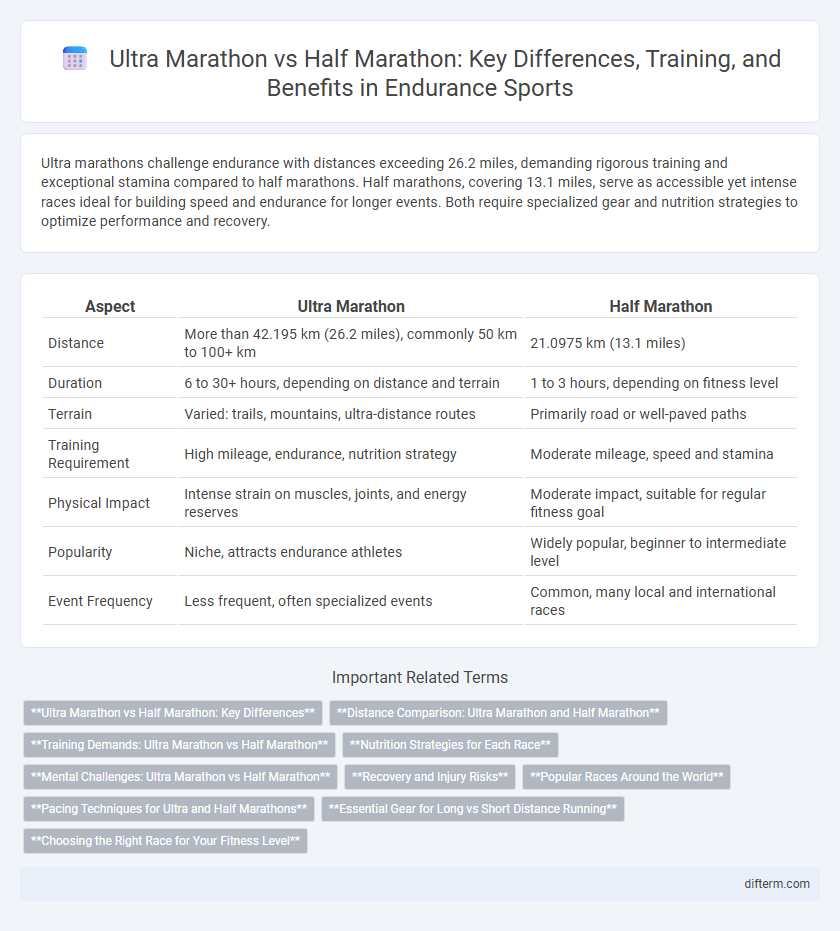Ultra marathons challenge endurance with distances exceeding 26.2 miles, demanding rigorous training and exceptional stamina compared to half marathons. Half marathons, covering 13.1 miles, serve as accessible yet intense races ideal for building speed and endurance for longer events. Both require specialized gear and nutrition strategies to optimize performance and recovery.
Table of Comparison
| Aspect | Ultra Marathon | Half Marathon |
|---|---|---|
| Distance | More than 42.195 km (26.2 miles), commonly 50 km to 100+ km | 21.0975 km (13.1 miles) |
| Duration | 6 to 30+ hours, depending on distance and terrain | 1 to 3 hours, depending on fitness level |
| Terrain | Varied: trails, mountains, ultra-distance routes | Primarily road or well-paved paths |
| Training Requirement | High mileage, endurance, nutrition strategy | Moderate mileage, speed and stamina |
| Physical Impact | Intense strain on muscles, joints, and energy reserves | Moderate impact, suitable for regular fitness goal |
| Popularity | Niche, attracts endurance athletes | Widely popular, beginner to intermediate level |
| Event Frequency | Less frequent, often specialized events | Common, many local and international races |
Ultra Marathon vs Half Marathon: Key Differences
Ultra marathons exceed the traditional marathon distance of 26.2 miles, ranging from 50 kilometers to 100 miles or more, demanding exceptional endurance and mental resilience. Half marathons cover 13.1 miles, offering a balance of speed and stamina suitable for both beginners and experienced runners aiming for a challenging yet accessible race. Training for ultra marathons requires a focus on prolonged energy management, terrain adaptability, and recovery, distinct from the speed-oriented and tempo-focused preparation typical for half marathons.
Distance Comparison: Ultra Marathon and Half Marathon
An ultra marathon covers any distance longer than the standard marathon length of 42.195 kilometers (26.2 miles), often ranging from 50 kilometers to over 100 miles, whereas a half marathon is precisely 21.0975 kilometers (13.1 miles). The ultra marathon requires significantly greater endurance, as athletes face extended terrain challenges and prolonged physical exertion compared to the relatively moderate distance of a half marathon. Training for ultra marathons demands more intensive preparation focused on stamina and mental resilience due to the extreme distances involved.
Training Demands: Ultra Marathon vs Half Marathon
Training demands for an ultra marathon require extensive endurance conditioning, including long runs exceeding 50 miles weekly, advanced nutrition strategies, and mental stamina development. Half marathon preparation focuses on improving speed and aerobic capacity with weekly mileage typically between 20 to 30 miles, incorporating tempo runs and interval training. Ultra marathon training emphasizes recovery and injury prevention due to prolonged physical stress, whereas half marathon training prioritizes pace consistency and lactate threshold improvement.
Nutrition Strategies for Each Race
Ultra marathon runners prioritize sustained energy intake through high-calorie, slow-digesting foods and frequent electrolyte replacement to combat extended muscle fatigue and dehydration. Half marathon athletes focus on carbohydrate loading 24-48 hours before the race and simple carbohydrate gels or drinks during the run to quickly replenish glycogen stores and maintain energy levels. Both rely on personalized hydration plans, but ultra marathons demand more complex nutrition strategies due to race duration exceeding several hours.
Mental Challenges: Ultra Marathon vs Half Marathon
Ultra marathons demand exceptional mental endurance due to their extreme distances often exceeding 50 kilometers, requiring runners to overcome intense physical fatigue and prolonged psychological stress. Half marathons, while challenging, involve less mental strain as the shorter 21.1-kilometer distance allows for more manageable pacing and focus. Coping strategies like visualization, self-talk, and pacing differ significantly between ultra marathoners and half marathoners, highlighting the heightened mental resilience required for ultra-distance events.
Recovery and Injury Risks
Ultra marathon recovery requires extended periods due to muscle fatigue, joint strain, and increased risk of overuse injuries compared to half marathons, which typically allow faster recovery times. Studies indicate ultra marathon runners face higher incidences of tendonitis, stress fractures, and chronic inflammation, whereas half marathon participants experience fewer severe musculoskeletal issues. Proper recovery protocols involving rest, nutrition, and physiotherapy are critical to minimize injury risks in ultra marathon training and post-race phases.
Popular Races Around the World
Popular ultra marathon races include the Western States 100 in the USA and the Ultra-Trail du Mont-Blanc in Europe, attracting elite endurance runners with challenging terrains. Half marathons such as the Great North Run in the UK and the Philadelphia Half Marathon in the USA draw large, diverse crowds due to their accessible distance and vibrant race-day atmospheres. Both race types boast global appeal, offering varied experiences for athletes seeking different levels of endurance challenges.
Pacing Techniques for Ultra and Half Marathons
Pacing techniques for ultra marathons emphasize steady, energy-conserving efforts, with runners often incorporating walk-run strategies and monitoring heart rate to maintain endurance over distances exceeding 50 kilometers. In contrast, half marathon pacing demands a more consistent, faster pace aimed at optimizing speed and minimizing fatigue throughout the 21.1-kilometer distance. Effective pacing in both events relies on personalized strategies based on terrain, fitness level, and race goals to maximize performance and prevent burnout.
Essential Gear for Long vs Short Distance Running
Ultra marathon runners require specialized gear such as hydration packs with high-capacity reservoirs, durable trail running shoes with enhanced grip, and compression apparel to manage muscle fatigue over extended distances. Half marathon participants typically prioritize lightweight running shoes, moisture-wicking clothing, and compact hydration solutions like handheld bottles or waist belts for shorter, faster runs. Proper gear selection directly impacts endurance, pace, and injury prevention specific to ultra marathon versus half marathon demands.
Choosing the Right Race for Your Fitness Level
Choosing the right race between an ultra marathon and a half marathon depends heavily on your current endurance and training commitment. Half marathons, covering 13.1 miles, suit runners building cardiovascular fitness and speed, while ultra marathons, often exceeding 50 miles, demand advanced stamina, mental resilience, and extensive preparation. Assessing personal goals, injury history, and available training time is crucial for aligning race choice with individual fitness levels.
ultra marathon vs half marathon Infographic

 difterm.com
difterm.com